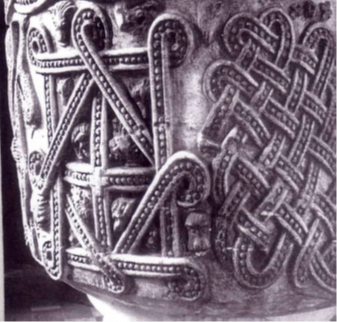PROVENANCE
This 12th century font is originally from the church of Hampstead Norreys (an historic village recorded in the Doomsday Book).
In the 18th century the parishioners there so misunderstood and disliked its carvings that they had tried, unsuccessfully, to obliterate them with a thick coat of plaster.
Finally in 1767 the font was altogether discarded from the church and dumped in the churchyard – later to be used first as a drinking trough and finally as a garden ornament.
Happily, after 80 years it was discovered by a Fellow of the Society of Antiquities through whom it was finally presented to the church of Stone to replace an equally ancient font which had suffered a totally destructive fate.
Thankfully now the battered old font from the church of Hampstead Norreys which was lovingly restored and set up in its new home at Stone is a much loved and photographed part of the fabric.

HISTORY
This wonderful font dates from 1140-50 and a careful comparison of carving styles indicates that it was probably the work of the craftsmen of the Reading Abbey workshops.
The founding Abbot of Reading was Hugh of Boves, formally Prior of the first Cluniac foundation in England at Lewes. Abbot Hugh had received his own monastic education in the great mother house of the Cluniac order, and as Abbot he would have laid the foundations of the Cluny observances in the new abbey of Reading. Furthermore, Hugh’s later training had been under that “Master of Masters”, Anselm of Laon. It was from the theological school of Laon that the first impulse towards a systemisation of theology derived, and following the lead given at Laon, systematic compilations of dogma were now being developed in the monastic and cathedral schools. These were known as Summae Sententiarum.
The earliest of all these new summaries of the accepted doctrines of the Christian faith was written by Master Hugh of Saint Victor (1096-1114) in the monastic school of Saint Victor on the south bank of the Seine outside Paris. It was called the De Sacramentis Christianae Fidei . The earliest library lists of Reading Abbey show that three copies of this work were kept at Reading and another in the library of their house in Leominster, so it is clear that this new form of Summa was of much interest to the community.
This remarkable work began with a statement: “There are two Works of God under which all things may be subsumed: these are the Work of Foundation (or Creation) and the Work of Restoration (or Salvation)”.
The carvings on the font, seen as a whole, do in fact illustrate in the pictorial form then current, the two essential Works of God, the Creation and Salvation of the World.
The carvings on the font are a very rare surviving summary of 12th century church dogma and they are rare because such carvings vanished from the repertoire of ecclesiastical sculpture after the close of the 12th century.
Being so unfamiliar to us today, the carvings on this font have been widely misinterpreted.
The carvings on the pictorial side of the bowl have vaguely been thought to illustrate Christ’s Descent into Hades- though the details of this scene have not been properly understood.
The geometric carvings on the other side of the bowl, however, have remained a mystery and have even been dismissed as mere decoration but their purpose was to illustrate the Cosmic Harmony within God’s Work of Creation in the macrocosm and the microcosm.

Mary C.Webb in her Ideas and Images in 12th Century Sculpture gives an account of the cosmology to which these carvings refer and explains the meaning of the four basic geometric designs – these being a circle interlaced with its arcs, a circle with its arcs double-looped, a square on a square and a rhomb on an oblong.
On the pictorial side of this font we are shown Christ as he descends into Hades, naked and alone, to stand between the two regents of Hell, Death as a wolf and Satan as a dragon.

The literary source of the carvings on this side of the font is the Ransom theory as expounded by Gregory the Great in his lengthy Commentary on the Book of Job, the Moralia in Job (completed shortly before he sent the Roman mission to Canterbury. The Moralia in Job was a very popular book and was listed, sometimes in duplicate, in many monastic libraries. The Ransom theory tells of how the Devil, who had tricked Adam in the Garden of Eden into eating the forbidden fruit, was himself deceived by God who, like a fisherman, hooked him, using Jesus as bait. The Devil, unaware that the human flesh offered was divine, was caught on the “Hook of Divinity” thus bringing upon himself his own destruction.
He offers his left hand as bait to the jaws of the dragon while he points his knife at Leviathan rising for the triple bait. This is Leviathan “whose flesh shall be sold as meat in the streets of Jerusalem at the coming of the Messiah”.
A salamander, symbolising the power of Christ to withstand all the fires of temptation, nestles against the leg of the Redeemer who tramples the serpent (the Tempter) underfoot. In his Moralia in Job Gregory describes Christ as the “Dear Bird from heaven”. In the 12th century Christ was not uncommonly depicted with wings and sometimes he was even depicted as a bird, usually a vulture.
On the font we see “the Dear Bird” pecking the monster.
Adam, wearing “the Helmet of Salvation” stands upon a leaf between God Incarnate and the Devil.
{Since the carvers of this font would have been familiar with Gregory ‘s Moralia they would also have known his very apt question , “What is man but a leaf who fell from Paradise from the Tree?” (Tree of Life)
The large bread roll which is being regurgitated from the jaws of Death is a reference to a 4th century hymn of Ephraim, “To others he multiplied bread but my bread from my mouth he steals it”. (A volume of Ephraim’s writings was listed in the Reading Abbey library lists )
After the 12th century this version of the Ransom theory was abandoned in favour of Anselm’s exposition of the doctrine of the Atonement and therefore carvings such as these vanished for ever from the repertoire of ecclesiastical sculpture . It is therefore to be hoped that the unique historical importance of the whole surviving corpus of 12th century carving may be more widely recognised and that this heritage will be preserved for posterity.
THE GEOMETRIC DESIGNS ON THE FONT BOWL
from HAMPSTEAD NORREYS
 A. CIRCLE interlaced with its arcs: the Macrocosm with the four elements |  B. CIRCLE with its arcs double-looped: probably the Microcosm |
 C. SQUARE ON A SQUARE: the perfection of number: a cube represented as two superimposed squares. |  D. RHOMB ON A OBLONG: probably harmonic proportion, reconciling good and evil. |
EPILOGUE
As a church we are very pleased to have been part of the preservation of this wonderful piece of history and hope that you have enjoyed seeing and reading more about our Font.
The Font is used for each baptism that is held in Stone Church and so many people surround it but don’t always realise the historical importance of it.
Many people have come during the years to see and photograph the Font and taken away the wonder of the sculptures on it that were done so long ago.
THANK YOU for taking the time to read this and please pass on to others the peculiar beauty which is shown on our precious possession.

